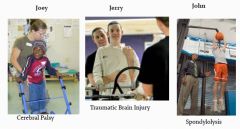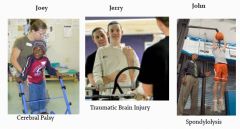![]()
![]()
![]()
Use LEFT and RIGHT arrow keys to navigate between flashcards;
Use UP and DOWN arrow keys to flip the card;
H to show hint;
A reads text to speech;
20 Cards in this Set
- Front
- Back
|
What is the ability to regulate or direct the mechanisms essential to movement?
a. Motor Control b. Proprioception c. Coordination d. All of the above |
a. Motor Control
|
|
|
What is a factor that contributes to understanding the nature of movement?
a. Task b. Individual c. Environment d. All of the above |
d. All of the above
|
|
|
Which of the following DOES NOT affect task?
a. Mobility b. Action c. Stability d. Manipulation |
b. Action
|
|
|
Which of the following DOES NOT affect the individual?
a. Cognition b. Perception c. Manipulation d. Action |
c. Manipulation
|
|
|
Which of the following does not pertain to the environment?
a. Mobility b. Regulatory c. Nonregulatory d. All of the above |
a. Mobility
|
|

Match the person with the need:
a. Stability b. Mobility c. Manipulation |
Joey- Mobility
Jerry- Stability John- Manipulation |
|
|
Which environmental constraint may affect performance?
a. Non-regulatory b. Regulatory |
a. Non-regulatory
|
|

Match the person with their environmental need:
A. Regulatory B. Non-regulatory |
Joey- Regulatory
Jerry- Regulatory John- Non-regulatory |
|
|
Theories reflect differences in opinion about the relative importance of various ________ components of movement.
a. Motor b. Musculoskeletal c. Neural c. Cognitive |
c. Neural
|
|
|
Which of the following is not related to the reflex theory?
a. Reflexes are the building blocks of complex behavior b. Movement behaviors interpreted in terms of the presence or absence of controlling reflexes c. Focus on enhancingor reducingthe effect of various reflexes during motor tasks d. Motor control emerges from reflexes that are nested within hierarchically organized CNS |
d. Motor control emerges from reflexes that are nested within hierarchically organized CNS
|
|
|
Which of the following is a limitation to the reflex theory?
a. Requires an outside agent b. Does not explain how a single stimulus results in varying responses c. Does not explain ability to produce new skills d. All of the above |
d. All of the above
|
|
|
Which theory is top-down?
a. Heirarchical b. Reflex c. Motor Programming d. None of the above |
a. Heirarchical
|
|
|
According to the hierarchical theory of motor control, brain injuries result in normal reflexes becoming:
a. Diminished b. Exaggerated c. Destroyed d. Persistent |
b. Exaggerated
|
|
|
Which of the following is not a motor program implication?
a. Muscle Memory b. CNS maturation is the primary agent for change in development c. Interventions should focus on retraining movements important to a functional task d. Suggests the importance of helping patients relearn the correct rules for action |
b. CNS maturation is the primary agent for change in development
|
|
|
Which of the following is not a motor program limitation?
a. Does not explain how a single stimulus results in varying responses b. Sensory Input and the Motor Cortex are parts of motor control c. Daily activities requires constant adjustments and refinements of movements d. Injury to the CNS results in complex adjustments in motor control |
a. Does not explain how a single stimulus results in varying responses
|
|
|
Which of the following is a characteristic of systems theory?
a. “Coordination of movement is the process of mastering the redundant degrees of freedom of the moving organism” b. "Biomechanics" c. Muscles work in “synergies” to accomplish movements d. All of the above |
d. All of the above
|
|
|
What does therapy of the systems theory include?
a. Involves re-organizing the systems coordination b. Involves re-educating the systems coordination c. Involves gradual and prolonged systems coordination d. Involves Joey, Jerry, and John |
a. Involves re-organizing the systems coordination
|
|
|
T/F The process of learning is observable
|
F
|
|
|
T/F Performance of a movement is observable
|
T
|
|
|
T/F Learning is a temporary change in movement
|
F
|

